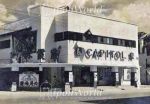We've tried to ensure the information displayed here is as accurate as possible. Should there be any inaccuracies, we would be grateful if you could let us know at info@ipohworld.org . All images and content are copyright.
(Please click on the thumbnail for a bigger image.)
The Capitol Cinema/Theatre Formerly Known As The Chung Wah Cinema - The Early History

This is a photograph of the Capitol Cinema taken in 1949. Capitol Cinema was also known as “King Do” in Cantonese. The cinema was re designed by B M Iversen, in 1937. He had designed many cinemas across the country.
However it is not generally known that the Capitol started its life as a newly built cinema named the Chung Wah cinema sometime before 1934. It was built by the J A Russell Company, who also owned the Isis and Jubilee Park. Archibald Russel, (Archie to most people) of Boh Tea fame, was, at the time, a major property owner with a comsiderable amount of Ipoh New Town in his portfolio.
It was in March 1935 that an agreement was made with Runme Shaww that both of the Russell Cinemas would be leased to Shaw Brothers for four years commencing in 1936. But then on 3 July 1937 (according to the minutes of the J A Russell company) it was decided to renovate the Capitol as trading conditions had improved. Consequently the Danish archiyect B M Iversen was tasked with the redesign. Part of this arrangement was that Runme Shaw would take a new lease of eight years at a monthly rental of $475 rising to $650 in the final year.
In October 1937 cost of the renovation had far outstrpped the estimates and consideration was given to demolshing the cinema and rebuildin a new one in "Chinese Style". Nonetheless the rebuild continued and did not complete until July 1938. Consequently Runme Shaw was paid compnsation of $18,00 for loss of earnings. Shaw Brothers declined an offer to purchase the building. Prior to the opening there were a number of problems all of which were laid at the contractor's door to rectify. These included a fall of the roof, poor finish to the pillars and walls and some realignment of cubicles. Eventually the cinema opened its doors to the public during August 1938.
Of course December 1941 saw the arrival of the Japanese and all local cinemas were closed down. Nothing more is known about the fate of the building during the war years, but a press cutting in our collection announce the reopening of both the Isis and Capitol in 1945. It is believed that by that tome Shaw Brothers had bought the cinema.
This photograph was probably taken not long after the outbreak of The Malayan Emergency; the date is based on the movie poster near the entrance - “Snowstorm in June” which was released in 1949. It was therefore also around the same time when Kuomintang relocated to Taiwan (as we can point out the Kuomintang flag flying from the window of the upper floor of the cinema, demonstrating support for the movement).
In the mid 60's, this area was a hive of activity by sundown. There were a lot of hawker stalls around the cinema selling gemstones, drinks, sweets, kacang puteh, sunglasses and cooling tea by the famous “Leong Suey Mui”. Meanwhile the five-foot way at the next building on the right housed Kok Cheong Kee, one of the city’s largest toy shops. Indeed, there were also three book stores in that block of shop houses, Tai Thong, Federal and Far East, all located next to each other. These sold Chinese books and pirated English and Chinese records. On the left was Theatre St with the famous twin brothers’ Char Kway Teow, the Satay Stick Steamboat, Wong Koong & Pak Koon Chicken rice stalls.
We are very grateful to Claire Grey, granddaughter of Archie Russel for providing us with extracts from the Minites of Board Meetings of J A Russel Co Ltd.